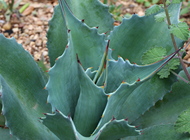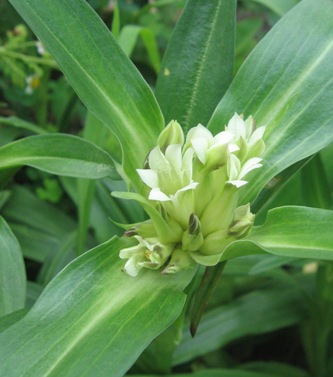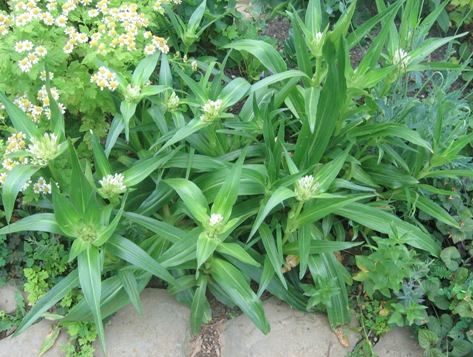 |
Gentiana tibetica |
 |
| Common name |
Tibetan gentian |
| Family |
gentianaceae |
| Life cycle |
perennial (Z6) |
| Flowers |
white |
| Size |
12" |
| Light |
sun-part shade |
| Cultural notes |
ordinary garden soil |
From seed  |
Give cold stratification, before germinating at room temperature. Exposure to light is helpful.
detailed seed-starting info below
|
| Seed ripens | early October |
Glossy, broad leaves, the largest among the gentians I've grown, maintain a strong presence in the garden throughout the growing season. White flowers appear in July. As the species name suggests, this is native to the Himalayas, where it occurs along roadsides and forest margins.
|
|
We left this plant behind in our Pennsylvania garden (and wish it well); we don't grow it in Houston. About my plant portraits
PlantLinks to other web pages about Gentiana tibetica
Visitors to this page have left the following comments| Sue Bound | Jul 05, 2005 | Hi there
Just letting you know that the Gentian asclepiadea alba grows to about 3 feet in new zealand but it is slower. Prefers part shade here. Is being trialled for cut flowers for export. |
| sabinski | Nov 12, 2005 | well, I can assure you it's NOT g. asclepiadea. maybe one of those asian species? it has beautiful leaves.
Thanks sabinski - I'll wait for more comments, as I'm still clueless... |
| Joanne | Dec 29, 2005 | I've been searching to buy this seeds for gentiana asclepiadea alba .Can't seem to find any around. Do you know where i could purchases these seeds .I'm from Toronto Canada Thanks Joanne
Mine came from seed trades. I don't know of a commercial source, off-hand. |
| Kate | Sep 08, 2006 | flavida? I don't think so; not enough differentiation of leaf size up (or down) the stalk. Why are you sure it's not asclepiadea? |
| Barry | Jul 12, 2008 | looks more like a white form of G. dauhrica - same moderately strapped leaves. |
| James Cheshire | Sep 11, 2008 | This is Gentiana tibetica. I'm certain. :-)
Thanks James - after reviewing the online references to G. t., I agree. I'm going to change the page accordingly. |
- Seed from '05 trade. Baggy 70F (3w) - 35F (38d) - 70F (90%G, 6-9d)
- Seed from '07 garden. Baggy 70F (3w) - 35F (6w) - 70F (90%G, 6-14d)
- Seed from '08 garden. Baggy 70F (3w; several G, 12-15d, but seedlings did not develop) - 35F (6w) - 70F (10d) - 70F with light (many G, 3-17d)
- Seed from '09 garden. Baggy 70F (30%G, 10-27d; seedlings did not develop).
Also Baggy 35F (6w) - 70F (56%G, 6-14). Although survival rate of germinated seeds was still low, those planted after their leaves were allowed to unfurl inside the baggy had a better probability of developing
- Seed from '09 garden. Baggy 35F (6w) - 70F (60%G, 6-18d). Again very low yield of plants from sprouted seeds.
- Seed from '09 garden. Baggy 35F (7w) - 70F (30%G, 10-16d). Yield low once again.
- Same seed as above. Baggy 35F (7w) - 70F (no G, 8w)
The 2009 trial suggests light is beneficial. Both 2009 and 2010 support the need for a cold stage in order for seedlings to be vigorous enough to develop.
I welcome comments about my web pages; feel free to use the form below to
leave feedback about this particular page. For the benefit of other visitors
to these pages, I will list any relevant comments you leave, and if
appropriate, I will update my page to correct mis-information. Faced with an
ever-increasing onslaught of spam, I'm forced to discard any comments including
html markups. Please submit your comment as plain text. If you have a
comment about the website as a whole, please leave it in my
guestbook. If you
have a question that needs a personal response, please
e-mail me.
Last modified:
April 25, 2014
Contact me
|




